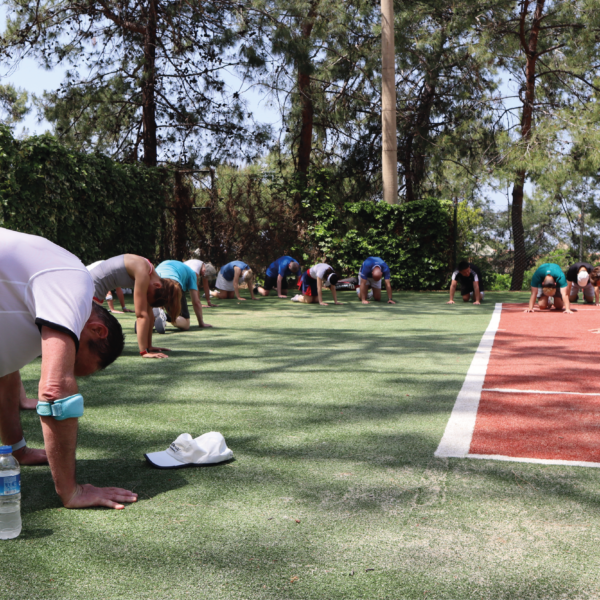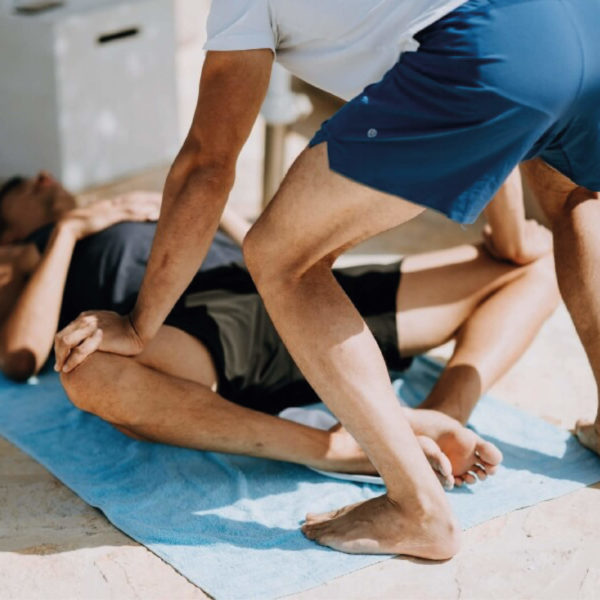
The Ultimate Tennis Elbow Guide
There are not many tennis holidays that I host without someone complaining of tennis elbow. It’s probably the most common injury I come across and unfortunately, once set in, is so difficult to get rid of.
HomeTennis Injuries
Tennis Injury Blog designed to help you battle an existing injury or prevent a future one from occurring, we are blogging from experience!
Tennis Injury
If you’re struggling with an existing Tennis Injury or want to prevent one from occurring in the future, read on for our tips. We’ve been there, done that – and we know how difficult it can be to rehab and get back to your normal activities. That’s why we’re sharing our experience and knowledge with you so you can prevent an injury from happening and treat it in the best way possible to get you back on court.

Tennis Injury Prevention
The most important part of preventing Tennis Injuries is to take steps to protect yourself before an injury arises and to do what you can to prevent a pre-existing injury from becoming more serious. Always warm up and stretch before playing. A warm up can be as long or as short as you want it to be but for your average club tennis player, we recommend 10-15 mins of stretching and activating your tennis muscles before hitting any balls (if you have time to warm up for longer, even better!) Your warm up can consist of dynamic stretches, light cardio, and our favourite – using bands to warm up the arms and shoulders. If you already have a pre-existing Tennis Injury, it may be worth taking some extra time to really focus on warm up as well as strengthening exercises (without pain) to hopefully improve how much you are affected by it. We recommend seeing a Doctor or Physiotherapist for proper advice on treating long term or painful injuries.
Another important Tennis Injury prevention tip is to cool down after each session. If you can make time for a cool down, you will seriously reap the benefits as it is a great way to ensure your body recovers after a tennis session or match. A 10–15-minute cool down with stretching will make all the difference to avoid pains and sores the next day and help a pre-existing issue or Tennis Injury you may already be playing through.
Here in the UK, we don’t need to worry too much about using sun cream and the heat but when we host our Tennis Holidays abroad, we prioritise protection from the sun and plenty of fluids to stay hydrated. Wearing tennis specific shoes rather than general sport shoes is also important for ankle and feet support when moving across the court. Look forward to our Tennis Shoes Blog coming soon for our personal reviews of certain shoes and what to look out for when buying Tennis equipment.

Tennis Injury Prevention Exercises
Tennis Injury prevention exercises are the perfect way for a keen player to stay fit and healthy and to avoid discomfort and muscle fatigue on court. You don’t have to go to the gym every day or take an hour out of your day to do them either. Most exercises for preventing injuries can be done where ever you would like to, from a work break environment to watching tele at home, and the best part is, you can spend as long as you want doing them.
Let’s say you don’t have time for injury preventing exercises or you find it boring and just want to play some tennis? What if you focused on one body part per day for 5-10 minutes? Although it may not seem like much time, if you completed a new exercise each day consistently or even just a few times a week, your athletic capabilities would improve (this includes tennis too) but most importantly, you are taking the steps towards having a healthier and injury free body.
Ankle Injuries – A common injury for tennis players. Due to having to move quickly around the court in short bursts and change direction constantly, feet and ankle injuries such as sprained ankles can occur. The following are three exercises that can help prevent ankle injuries by focusing on strengthening and stretching the muscles for better balance:
1) Stand on one foot with the other in the air a few inches above the ground and then slowly lower the other foot towards the ground. Repeat 10 times on each side focusing on a well-controlled rhythm.
2) Performing the ankle alphabet to improve your range of motion. Draw out each letter of the alphabet with your ankle whilst sitting on the floor. Use a rolled-up piece of clothing or a towel to elevate your legs for extra comfort. Try to use this exercise as a warm up and cool down.
3) Walking heel-to-toe across a room. Begin on your heel and lift up, ending with moving the pressure onto your toes before taking your next step. Repeat 10 times on each side.
Also for warm ups – ankle exercises are a great way to get the blood flowing in these muscles so more oxygen can reach them and you are ready to play.
Calf Muscle Injuries – If you play tennis, you’re at risk for calf muscle injuries from muscle fatigue or overuse. These injuries can side-line you for weeks in extreme cases, so it’s important to take steps to prevent them. Noticing a slight pain or pulling feeling in your calf muscles is a sign that they need a good stretch and also some strengthening so that the muscles do not become easily fatigued when playing.
1) One easy exercise is to stand with your feet hip-width apart and rise up onto your toes, then go down again. This can be done in 3 sets of 10-15 reps. You can also do a calf raise by standing on one leg and lifting the other heel up as high as possible which I normally prefer to do so I can focus on a single calf muscle then switch to the other one. Hold for two seconds before coming down and repeat 10 times on each leg.
2) You can also try this stretch: Sit on the ground with your left ankle resting on your right knee. Gently pull your toes towards your shin until you feel a stretch in your calf muscle. Repeat this 2-3 times and for 30 seconds on each side.
3) My favourite calf muscle stretch is to put your hands against a wall or something you can grab onto and bring one leg in front and bent slightly and the other behind. Try to straighten your back leg as much as possible to feel a deep calf stretch (especially great after a tough session or if your calves feel tight). Repeat this 2-3 times and for 30 seconds on each side.
Shoulder Injury – The shoulder is a complex joint that can be long term or common injury for tennis players. With shoulders, it is important to start by stretching your muscles before playing. Flexibility is also important for preventing injuries. Stretching the muscles and tendons around the shoulder can help them stay loose and flexible. There are many different stretches that you can do, but make sure you hold each stretch for at least 30 seconds. Here are two of our favourites.
1) One simple exercise that can be done at home is to stand with your arm out to the side, and then raise it up above your head. You can also do resistance exercises using elastic bands or weights. Hold for 30 seconds and repeat twice on each side.
2) Another great shoulder exercise is the across the chest stretch. Cross your right arm over your chest. Place it in-between your left forearm and elbow, supporting your right arm with your left hand. Maintain this posture for 30 seconds. Repeat the process on the other side. (2-4 times on each side).
3) Racket Warm Up – Before warming up your serves you can do what we like to call the Serena figure of 8’s. Serena Williams will practice her serving motion without a ball and as she ends her motion, she will carry it over like a figure of 8 and is back at the beginning without stopping to go again. Repeat this 5-10 times gradually swinging faster each time.

Tennis Injury Rules
There are some basic rules that can be followed to help prevent Tennis Injuries and we have listed our top tips to follow which we have used over the course of our Tennis journeys.

Tennis Injury – Strengthening Exercises
Regular strengthening exercises are important for overall health and fitness, and can help prevent injuries. Tennis players need to focus on exercises that will improve strength, flexibility and balance. These exercises will help you become faster on court and your muscles will be able to withstand more tension which will help protect you from injuries. Some good exercises we like to do that we haven’t yet touched on for lower body are bridges, squats, and lunges.
1) To do a bridge, lie on your back with your feet flat on the ground and your legs bent. Bring your hips up off the ground until your body forms a straight line from your head to your feet. Hold this position for 5 seconds, then lower yourself back down. This will strengthen your lower back and glutes. Repeat 10 times and when lowering down engage your lower core to release any tension within your lower back muscles.
2) For a simple squat, stand shoulder-width apart with your toes turned out slightly. Bend down until your thighs are parallel to the ground or as far down as you can go knowing you will be able to come back up. We recommend holding this position for 5 seconds, then raise yourself back up. Repeat 10 times. For squat variations why not try a weighted squat or squat with your hands above your head.
3) There are many ways to do a lunge, but all of them involve stepping forward with one leg and bending the other knee so that your thigh is parallel to the ground. You can hold your hands together in front of you or behind your head for balance. When doing a lunge, make sure to keep your back straight and your core engaged. Don’t let your front knee go over your toes, and be sure to push off with your back foot when you return to standing. Aim for 2-3 sets of 8-10 lunges on each side.
If you’re new to lunges, start by doing them slowly and holding the position for a few seconds. As you get stronger, you can gradually increase the speed and duration of each lunge. We are focusing on lower body here because these exercises are brilliant for strengthening the quadriceps, hamstrings, and glutes. They can also help improve balance and stability on court when setting up to hit your shot.
4) You can also improve your upper body strength by doing some basic exercises like shoulder presses (raising a bar above your head) and rows (pulling a bar into your body). These exercises will help keep your muscles strong and flexible, which can help protect you from injuries and there is no need to go heavy on the weight as you are training for flexibility which is why for tennis, we recommend using bands for these types of strengthening exercises.
5) Remember that regular stretching can help you become stronger as well. Stretching lengthens muscle tissue and enhances flexibility, which can make you feel more agile and improve your athletic performance. We encourage you to stretch even if you have no injuries or soreness as it will prevent them from happening. As coaches and players, we have seen the same story occur many times where a player never stretches because they have never had an injury and over time it can lead to a big injury with a long rehabilitation time before they are able to get back on court. Check out our blog on Tennis Fitness for more key information on improving your tennis game.
If you think we missed out on telling you about the most common injury – Tennis Elbow, don’t worry as we have two blogs specifically about Tennis Elbow which you can click on here. The Ultimate Tennis Elbow Guide and Do you Suffer from Tennis Elbow.
With a little bit of attention to safety, you can enjoy the sport you love without the worries and pains of a Tennis Injury.


There are not many tennis holidays that I host without someone complaining of tennis elbow. It’s probably the most common injury I come across and unfortunately, once set in, is so difficult to get rid of.

Having been involved in competitive tennis now for just over 20 years, its fair to say I have had my fair share of injuries. The







| Cookie | Duration | Description |
|---|---|---|
| cookielawinfo-checkbox-analytics | 11 months | This cookie is set by GDPR Cookie Consent plugin. The cookie is used to store the user consent for the cookies in the category "Analytics". |
| cookielawinfo-checkbox-functional | 11 months | The cookie is set by GDPR cookie consent to record the user consent for the cookies in the category "Functional". |
| cookielawinfo-checkbox-necessary | 11 months | This cookie is set by GDPR Cookie Consent plugin. The cookies is used to store the user consent for the cookies in the category "Necessary". |
| cookielawinfo-checkbox-others | 11 months | This cookie is set by GDPR Cookie Consent plugin. The cookie is used to store the user consent for the cookies in the category "Other. |
| cookielawinfo-checkbox-performance | 11 months | This cookie is set by GDPR Cookie Consent plugin. The cookie is used to store the user consent for the cookies in the category "Performance". |
| viewed_cookie_policy | 11 months | The cookie is set by the GDPR Cookie Consent plugin and is used to store whether or not user has consented to the use of cookies. It does not store any personal data. |